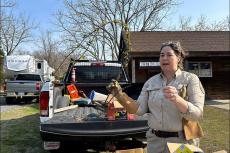Orsted and Eversource, joint developers of the South Fork Wind farm, have announced an agreement with environmental groups to further enhance measures aimed at protecting the critically endangered North Atlantic right whale during construction and operation of the wind farm.
Under the agreement with the National Wildlife Federation, Natural Resources Defense Council, and Conservation Law Foundation, the developers will adopt a number of monitoring measures to help ensure right whales are not in close proximity to the site during construction activities, implement mitigation to reduce noise during pile driving, and evaluate other new monitoring technologies. To guard against vessel strikes, the agreement also includes a 10-knot speed limit for all project-related vessels unless an effective adaptive speed management plan is in place.
The developers will test advanced technologies that detect and have the potential to track whales, including thermal cameras, acoustic sensors, and data integration software.
Orsted is funding an app called WhaleAlert that tracks whales and distributes information to help vessels avoid collisions. The company has made other investments in tracking software, and is partnering with national and international academic institutions to advance biodiversity efforts.
The South Fork Wind farm will be a pilot program for these provisions, and the companies may use them in future projects.
Scientists estimate that there are fewer than 340 North Atlantic right whales. The environmental organizations are working to advance offshore wind energy as a resource to combat climate change, aiming to establish the industry in a way that includes protections for vulnerable marine life and habitat. The groups are working across sectors to address impacts to North Atlantic right whales, which are threatened by entanglement in fishing gear and vessel collisions, and by shifting prey and habitat availability due to climate change.
Onshore construction of South Fork Wind, New York State’s first offshore wind farm, is underway. The offshore installation will be located 35 miles east of Montauk Point, and its 12 turbines will generate approximately 130 megawatts of power. It is expected to be operational in late 2023.




